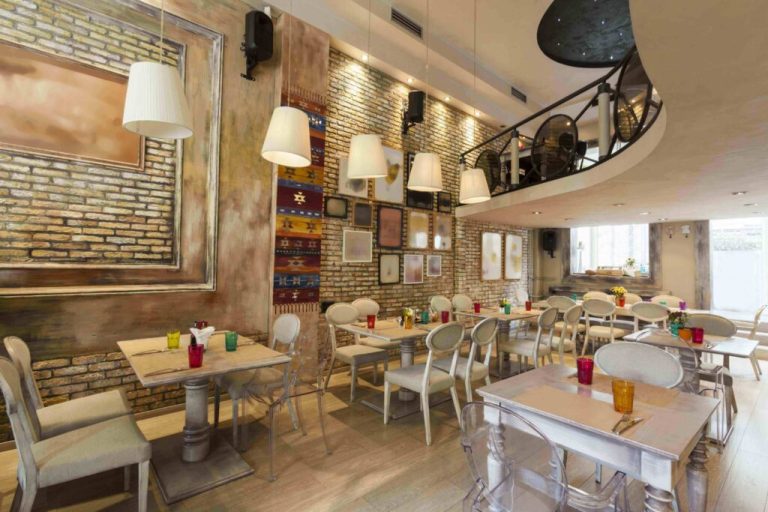Ergonomic concerns are critical in the dynamic world of commercial-grade restaurant furniture, where aesthetics and utility intersect. As restaurants try to offer exceptional dining experiences, furniture design, and comfort are critical considerations.
This article looks into the complexities of ergonomic considerations in commercial-grade restaurant furniture, examining how these components not only improve customer pleasure but also contribute to a restaurant’s overall performance.
Understanding Ergonomics
Ergonomics, which is frequently disregarded in favor of appearance, is the science of designing restaurant furniture to improve human well-being and overall effectiveness. It goes beyond simply comfort to include variables such as efficiency, production, and even economic impact.
Integrating ergonomic concepts into restaurants is more than just a design option; it is a strategic investment in creating an environment that resonates with customers and generates a happy attitude for employees.
Adopting such concepts in commercial environments goes beyond aesthetics in terms of ergonomics. It also includes the long-term benefits that businesses gain, such as increased customer loyalty and employee productivity.
Restaurants can obtain a competitive advantage in an industry where the customer experience is critical by matching design decisions with ergonomic principles.
Types of Commercial-Grade Restaurant Furniture
The selection of restaurant furniture is as varied as the establishments themselves. Seating options range from traditional chairs and booths to modern barstools and couches. Similarly, tables exist in a variety of shapes and sizes, each with a unique purpose.
In the modern context, institutions are also exploring modular and reclining seating solutions to ensure versatility in catering to varied consumer needs.
Table options include adjustable height tables, folding tables, and even community tables, which promote a social dining experience. The value of personalization is clear, as businesses strive to build one-of-a-kind locations that reflect their corporate identity and resonate with their target audience.
Ergonomic Considerations in Seating
When it comes to sitting, the emphasis moves to the details that determine comfort. Seat height and depth, backrest design, and armrest height all contribute significantly to a chair’s or booth’s overall ergonomic profile.
The addition of lumbar support features and reclining choices improves the overall experience, allowing patrons to dine for longer periods of time without feeling uncomfortable.
Seating angles, which are sometimes ignored, are critical in designing an environment that fits a variety of body types and preferences. A well-planned seating arrangement addresses not just individual preferences but also the restaurant’s spatial dynamics, resulting in an inviting and pleasant setting.
Ergonomic Considerations in Tables
Tables are also ergonomically designed, with considerable thought given to their height, form, and size. Materials and durability are extremely important, especially in high-traffic locations. Beyond the essentials, surface texture, edge profiles, and even cable management solutions help to improve the tables’ overall ergonomics.
Accessibility becomes an important factor, with the design ensuring that people with various needs can easily use the table area. This inclusivity not only appeals to a larger customer base, but also resonates with modern principles such as diversity and equal access.
Importance of Durability in Commercial Environments
Restaurant furniture experiences unmatched wear and strain due to continual use and occasional spillage. As a result, durability becomes a key consideration when selecting commercial-grade furniture. The resistance to spills and stains, combined with ease of care and longevity, ensures that the investment in furniture pays off over time.
Quality assurance testing is critical to ensuring that the furniture can sustain intensive use without compromising comfort or safety. Sustainable and recyclable materials add to the durability factor, harmonizing with the increased emphasis on ecologically responsible operations.
Design Aesthetics and Ergonomics
While practicality is critical, the aesthetic value of commercial restaurant furniture should not be disregarded. Balancing aesthetics with comfort has become an art form, with businesses aiming to create visually appealing places that are consistent with their brand identity.
Customization possibilities, such as color psychology, lighting considerations, and spatial arrangement, enable a harmonious combination of design elements.
The strategic use of furniture to tell a company story and create a memorable eating experience is a valuable tool in today’s competitive landscape. Outdoor furniture, when correctly chosen and installed, can expand the dining experience beyond the four walls, adding a touch of refinement to the overall mood.
Technology Integration in Furniture Design
The future of commercial-grade restaurant furniture lies in the incorporation of smart technologies. Wireless charging capabilities, digital displays in tables, and IoT-enabled furniture not only enhance the dining experience but also demonstrate a dedication to innovation.
As technology advances, furniture evolves into a dynamic and interactive component of the whole dining experience.
Restaurants that embrace these technological developments position themselves as forward-thinking enterprises, catering to a tech-savvy customer while staying ahead in an ever-changing sector.
Fostering Ergonomic Excellence in Restaurant Spaces
Ergonomic factors are critical to the success of developing outstanding dining experiences. Restaurants may improve the overall experience for both customers and employees by carefully aligning design decisions with principles that prioritize comfort, functionality, and safety.
The combination of aesthetics and ergonomics produces a harmonious balance, promoting an atmosphere in which customers feel both welcomed and pampered. From initial seating choices to the innovative incorporation of technology, every aspect contributes to the restaurant’s narrative, establishing its character and influencing customer views.
As the industry advances, the urge to constantly examine, adapt, and innovate in restaurant furniture design becomes a rallying cry for businesses seeking not only longevity but continued greatness.
Restaurants may rise above the ordinary by promoting ergonomic excellence, creating settings that leave a lasting impression on their customers’ memory, and establishing a place at the forefront of an ever-changing industry.

